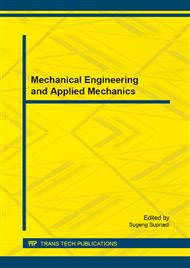[1]
M. Boujelbene, E. Bayraktar, W. Tebni and S. B. Salem, Influence of machining parameters on the surface integrity in electrical discharge machining, Archives of Material Science and Engineering 37 (2009) 110-116.
DOI: 10.4028/www.scientific.net/amr.83-86.725
Google Scholar
[2]
A. Kumar and D. K. Singh (2012), Strategic optimization and investigation effect of process parameters on performance of wire electric discharge machine (WEDM), Int. J. of Eng. Science and Technology 4 (2012), 2766-2772.
Google Scholar
[3]
R. K. Singh, D. K. Singh and V. Kumar, Parametric Optimization of Wire-EDM by Using Fuzzy Logic, IJBSTR Research Paper (2013), 37-41.
Google Scholar
[4]
P. Kumar, B. Bhushan R.K. Gupta, Response of Wire Electrical Discharge Machining For H13 Using Taguchi L9 Array, Int. J. of Eng. Res. and Applications, 3 (2013), 907-912.
Google Scholar
[5]
H.C. Liao, Multi-Response Optimization using Weighted Principal Component, International Journal of Advanced Manufacturing Technology. 27 (2006) 720-725.
DOI: 10.1007/s00170-004-2248-7
Google Scholar
[6]
S. S. Mahapatra, A. K. Sood, S. K. Patel and S. Sahu, Optimization of Process Parameters in Fused Deposition Modeling using Weighted Principal Component Analysis, the 3th International Conference on Global Interdependence and Decision Sciences, Administrative Staff College of India (ASCI) from 28th to 30th Dec 2009, Hyderabad, India.
Google Scholar
[7]
S. Datta and S. S. Mahapatra, Bead Geometry Optimization of Submerged Arc Weld: Exploration of Weighted Principal Component Analysis (WPCA), 2nd International Conference on Mechanical, Industrial and Manufacturing Technologies 2011 (MIMT), Singapore.
DOI: 10.4028/www.scientific.net/amm.110-116.790
Google Scholar
[8]
B. S. Choudhury. S. Datta and R. S. Sen, Parametric Optimization of Electroless Ni-P Coating Using Weighted Principal Component Analysis (WPCA) and Taguchi Method, International Journal of Applied Engineering Research, 5 (2010) 4.
Google Scholar
[9]
G. Taguchi, Introduction to Quality Engineering, Asian Productivity Organization, Tokyo (1990).
Google Scholar
[10]
K. H. Hsia and H. Wu, A study on the data processing in grey relation analysis, J. Chin, Grey Syst. Assoc. 1 (1998) 47-53.
Google Scholar
[11]
J.L. Lin and C.L. Lin, The use of Grey-Fuzzy Logic for the Optimization of the Manufacturing Process, J. Mater. Processing Technol. 160 (2005) 9-14.
Google Scholar
[12]
P. J. Ross, Taguchi Techniques for Quality Engineering, 2nd ed., McGraw-Hill Intl. Editions (2008).
Google Scholar


